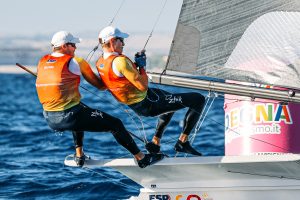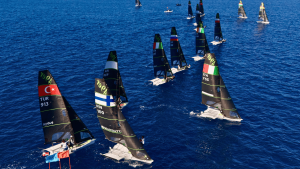ISAF has announced a new pinnacle event that will occur annually in Abu Dhabi. To the best of our knowledge at the time of release, these are some of the details.
The Sailing World Cup Finals will be an exciting and highly competitive event with only the top 20 teams from each Olympic event plus kitesurfing invited. The race format will likely mirror the Olympics, as it mirrors most of the Olympic fleet sizes, and signifies a significant shift in how ISAF will approach the Sailing World Cup events in general. Prize money, logistics stipends, and accommodation, should be enough to attract the worlds best sailors to attend at what was previously a rest period for most Olympic sailors.
The 2014 event is the first year of a 4 year contract to host the finals through 2017 in Abu Dhabi, and is scheduled for the final week of November in 2014. For the most part, teams will be competing in boats provided by the organizers, on a level playing field, for a winner takes all SWC crown. In 2014 the qualification process will be mostly through performance at the ISAF World Championship in Santanter, with additional places going to invitees and/or teams highly ranked in the World Cup standings. In future years, there will be a more distributed approach to winning spots in the Final, with winners from SWC events, World Championships and (hopefully) Continental Championships.
For years the SWC has been a collection of regattas, given additional importance through inclusion in various forms of the SWC. With the SWC Final established, ISAF will turn it’s attention to the rest of the SWC circuit, and sailors can expect limited fleet sizes with a fan focussed agenda rather than a participation focussed agenda. There will in essence be two sailing circuits. The SWC will be for the established top performing teams and there will be a development circuit of events more typical to how sailing looks like now. These event will have unlimited fleet sizes and ride on the quality of the fleet attendance and organizing committees ability to attract sponsorship.
This change was called for in the Olympic Commission report from 2010 and is the first launching point for change in the Sailing World Cup in general. The initial concept floated at the 2013 ISAF conference had a vision of 10 boat fleets, but ultimately a 20 boat fleet was agreed upon due to the symmetry with the Olympic games fleets and to increase the visual impact of the racing. The event was initially marketed as a replacement for traditional class World Championships, and it may still aim to claim that crown. This 4 year period should be looked at as a testing ground for the concept, at which point sailors and sailing fans can decide how World Champions should be crowned.
There is also much risk remaining in the concept. Having Abu Dhabi backing the event for 4 years will leave the Finals in good standing, but it will be up to ISAF to sign commercial sponsors in order to make the World Cup circuit itself stand up. It is one thing to invite 240 crews to an event on provided boats, it is a whole other thing to ship ~500 crews around the globe on a virtually continuous regatta circuit. With the Grand Final, ISAF has a pinnacle event they can control and market, which should attract the sort of sponsorship Olympic sailing has yearned for.
One thing is for sure, and that is a season ending event with the top 20 from each class will be a spectacular regatta. The racing will be second to none in sailing, and sailing fans around the world should rejoice at the opportunity to finally see the world’s best sailors race annually in a great format.







